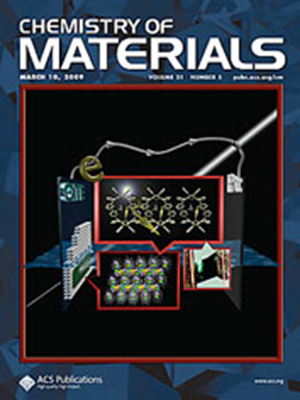Responsive Liquid Crystalline Materials Based on Interfacial Photocatalytic Processes
IF 7.2
2区 材料科学
Q2 CHEMISTRY, PHYSICAL
引用次数: 0
Abstract
Here we address if it is possible to couple changes in liquid crystal (LC) ordering with photocatalytic processes occurring on surfaces to enable the design of photoresponsive materials. We report that ultraviolet (UV) illumination of anatase (101) supporting 4′-n-pentyl-4-biphenylcarbonitrile (5CB) leads to a change in LC ordering driven by photo-oxidation of 5CB to 4′-cyano-4-biphenylcarboxylic acid (CBCA), as confirmed by infrared spectroscopy and mass spectrometry. Specifically, we find that a 0.09 monolayer (ML) surface coverage of the product CBCA on anatase (101) is sufficient to trigger the ordering transition of the LC from planar to homeotropic, thus reporting the transformation with high sensitivity. Additionally, we observe that the LC ordering serves as a reporter of the amount of adsorbed water on anatase (101), a key molecular species involved in the photocatalytic transformation of 5CB. We also demonstrate that the LC film alters the local concentration and structure of water adsorbed on titania, as characterized using infrared spectroscopy and electronic structure calculations. Lastly, the competitive adsorption of water and LC on anatase (101) is reported as a nonmonotonic trend in the rate of photocatalytic transformation of LC as a function of RH levels, a phenomenon captured by the rate of change of LC order. In summary, these results demonstrate that LCs couple to photocatalytic transformations on titania, offering designs of photoresponsive LCs, a novel readout of photocatalytic molecular events and the ability to tune interfacial photocatalytic processes.

求助全文
约1分钟内获得全文
求助全文
来源期刊

Chemistry of Materials
工程技术-材料科学:综合
CiteScore
14.10
自引率
5.80%
发文量
929
审稿时长
1.5 months
期刊介绍:
The journal Chemistry of Materials focuses on publishing original research at the intersection of materials science and chemistry. The studies published in the journal involve chemistry as a prominent component and explore topics such as the design, synthesis, characterization, processing, understanding, and application of functional or potentially functional materials. The journal covers various areas of interest, including inorganic and organic solid-state chemistry, nanomaterials, biomaterials, thin films and polymers, and composite/hybrid materials. The journal particularly seeks papers that highlight the creation or development of innovative materials with novel optical, electrical, magnetic, catalytic, or mechanical properties. It is essential that manuscripts on these topics have a primary focus on the chemistry of materials and represent a significant advancement compared to prior research. Before external reviews are sought, submitted manuscripts undergo a review process by a minimum of two editors to ensure their appropriateness for the journal and the presence of sufficient evidence of a significant advance that will be of broad interest to the materials chemistry community.
 求助内容:
求助内容: 应助结果提醒方式:
应助结果提醒方式:


